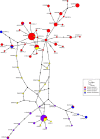Worldwide relationships in the fern genus Pteridium (bracken) based on nuclear genome markers
- PMID: 31545874
- PMCID: PMC6856829
- DOI: 10.1002/ajb2.1365
Worldwide relationships in the fern genus Pteridium (bracken) based on nuclear genome markers
Abstract
Premise: Spore-bearing plants are capable of dispersing very long distances. However, it is not known if gene flow can prevent genetic divergence in widely distributed taxa. Here we address this issue, and examine systematic relationships at a global geographic scale for the fern genus Pteridium.
Methods: We sampled plants from 100 localities worldwide, and generated nucleotide data from four nuclear genes and two plastid regions. We also examined 2801 single nucleotide polymorphisms detected by a restriction site-associated DNA approach.
Results: We found evidence for two distinct diploid species and two allotetraploids between them. The "northern" species (Pteridium aquilinum) has distinct groups at the continental scale (Europe, Asia, Africa, and North America). The northern European subspecies pinetorum appears to involve admixture among all of these. A sample from the Hawaiian Islands contained elements of both North American and Asian P. aquilinum. The "southern" species, P. esculentum, shows little genetic differentiation between South American and Australian samples. Components of African genotypes are detected on all continents.
Conclusions: We find evidence of distinct continental-scale genetic differentiation in Pteridium. However, on top of this is a clear signal of recent hybridization. Thus, spore-bearing plants are clearly capable of extensive long-distance gene flow; yet appear to have differentiated genetically at the continental scale. Either gene flow in the past was at a reduced level, or vicariance is possible even in the face of long-distance gene flow.
Keywords: allotetraploid; fern; hybrids; introgression; long distance gene flow; spore-bearing plants.
© 2019 The Authors. American Journal of Botany published by Wiley Periodicals, Inc. on behalf of Botanical Society of America.
Figures






References
-
- Alonso‐Amelot, M. E. , and Avendano M.. 2002. Human carcinogenesis and bracken fern: A review of the evidence. Current Medicinal Chemistry 9: 675–686. - PubMed
-
- Andrews, K. R. , and Luikart G.. 2014. Recent novel approaches for population genomics data analysis. Molecular Ecology 23: 1661–1667. - PubMed
-
- Boodle, L. A. 1903. The structure of the leaves of the bracken (Pteris aquilina, Linn.) in relation to environment. Botanical Journal of the Linnean Society. Linnean Society of London 35: 659–669.
-
- Bretagnolle, F. , and Thompson J. D.. 1995. Gametes with the somatic chromosome number: Mechanisms of their formation and role in the evolution of autopolyploid plants. New Phytologist 129: 1–22. - PubMed
-
- Bright, D. N. E. 1928. The effects of exposure upon the structure of certain heath‐plants. Journal of Ecology 16: 323–365.
Publication types
MeSH terms
Grants and funding
LinkOut - more resources
Full Text Sources
Miscellaneous

